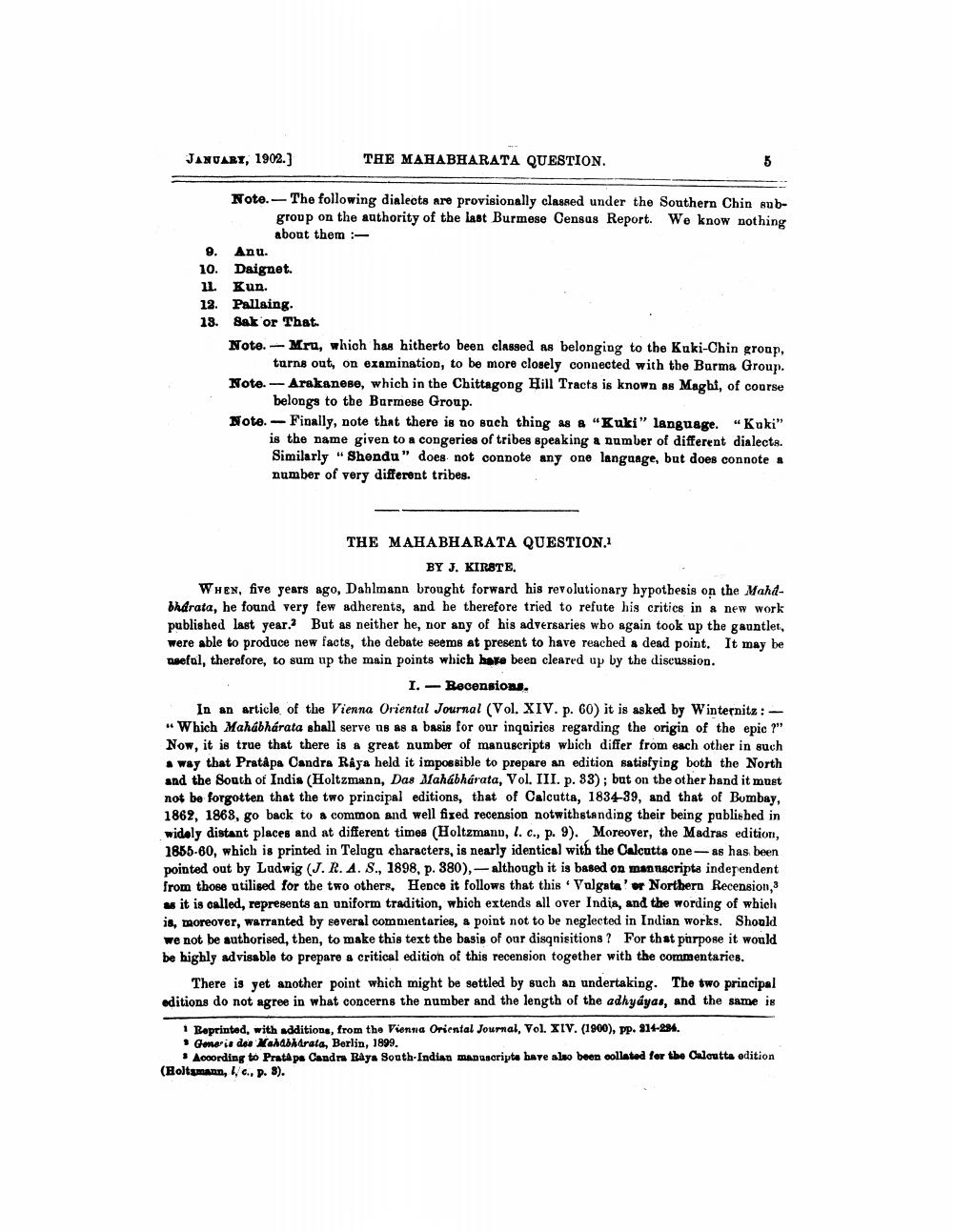Book Title: Indian Antiquary Vol 31 Author(s): Richard Carnac Temple Publisher: Swati Publications View full book textPage 9
________________ THE MAHABHARATA QUESTION. Note. The following dialects are provisionally classed under the Southern Chin subgroup on the authority of the last Burmese Census Report. We know nothing about them : JANUARY, 1902.] Anu. Daignet. 9. 10. 11. Kun. 12. Pallaing. 13. Sak or That. 5 Note. Mru, which has hitherto been classed as belonging to the Kuki-Chin group, turns out, on examination, to be more closely connected with the Burma Group. Note. Arakanese, which in the Chittagong Hill Tracts is known as Maghi, of course belongs to the Burmese Group. Note. Finally, note that there is no such thing as a "Kuki" language. "Kuki" is the name given to a congeries of tribes speaking a number of different dialects. Similarly "Shendu" does not connote any one language, but does connote a number of very different tribes. THE MAHABHARATA QUESTION.1 BY J. KIRSTE. WHEN, five years ago, Dahlmann brought forward his revolutionary hypothesis on the Mahdbharata, he found very few adherents, and he therefore tried to refute his critics in a new work published last year. But as neither he, nor any of his adversaries who again took up the gauntlet, were able to produce new facts, the debate seems at present to have reached a dead point. It may be useful, therefore, to sum up the main points which have been cleared up by the discussion. I. Recensions. In an article of the Vienna Oriental Journal (Vol. XIV. p. 60) it is asked by Winternitz:"Which Mahabharata shall serve us as a basis for our inquiries regarding the origin of the epic ?" Now, it is true that there is a great number of manuscripts which differ from each other in such a way that Pratapa Candra Râya held it impossible to prepare an edition satisfying both the North and the South of India (Holtzmann, Das Mahabharata, Vol. III. p. 33); but on the other hand it must not be forgotten that the two principal editions, that of Calcutta, 1834-39, and that of Bombay, 1862, 1868, go back to a common and well fixed recension notwithstanding their being published in widely distant places and at different times (Holtzmann, I. c., p. 9). Moreover, the Madras edition, 1855-60, which is printed in Telugu characters, is nearly identical with the Calcutta one-as has been pointed out by Ludwig (J. R. A. S., 1898, p. 380),—although it is based on manuscripts independent from those utilised for the two others. Hence it follows that this Vulgata' or Northern Recension,3 as it is called, represents an uniform tradition, which extends all over India, and the wording of which is, moreover, warranted by several commentaries, a point not to be neglected in Indian works. Should we not be authorised, then, to make this text the basis of our disquisitions? For that purpose it would be highly advisable to prepare a critical edition of this recension together with the commentaries. There is yet another point which might be settled by such an undertaking. The two principal editions do not agree in what concerns the number and the length of the adhyayas, and the same is 1 Reprinted, with additions, from the Vienna Oriental Journal, Vol. XIV. (1900), pp. 214-234. Generis des Mahabharata, Berlin, 1899. According to Pratapa Candra Raya South-Indian manuscripts have also been collated for the Calcutta edition (Holtsmann, c., p. 8).Page Navigation
1 ... 7 8 9 10 11 12 13 14 15 16 17 18 19 20 21 22 23 24 25 26 27 28 29 30 31 32 33 34 35 36 37 38 39 40 41 42 43 44 45 46 47 48 49 50 51 52 53 54 55 56 57 58 59 60 61 62 63 64 65 66 67 68 69 70 71 72 73 74 75 76 77 78 79 80 81 82 83 84 85 86 87 88 89 90 91 92 ... 556
